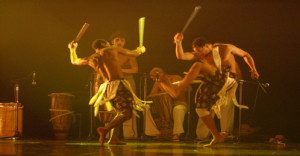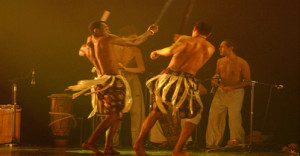 In the state of Baίa, but nowadays particularly in Santo Amaro exist religious celebrations, mixed with profane elements. Among the traditions represented at the entrance of the Boa Măe (Good Mother) Church, we can find Capoeira d’Isabel, Bumba, Meu Boi, á Burrinha and of course, Maculélé,the height of the festivities.Maculélé is a dramatic dance, marked by the rhythm of the Atabaques (drums), during which a group of men holding wooden sticks are fighting against each other. After the abolition of slavery in 1888, Maculélé declined and disappeared completely. It would have totally disappeared if in 1943 Master Pópó had not decided to gather friends and family to recreate Maculélé, organizing a demonstration in front of the Church of the Purification.
In the state of Baίa, but nowadays particularly in Santo Amaro exist religious celebrations, mixed with profane elements. Among the traditions represented at the entrance of the Boa Măe (Good Mother) Church, we can find Capoeira d’Isabel, Bumba, Meu Boi, á Burrinha and of course, Maculélé,the height of the festivities.Maculélé is a dramatic dance, marked by the rhythm of the Atabaques (drums), during which a group of men holding wooden sticks are fighting against each other. After the abolition of slavery in 1888, Maculélé declined and disappeared completely. It would have totally disappeared if in 1943 Master Pópó had not decided to gather friends and family to recreate Maculélé, organizing a demonstration in front of the Church of the Purification.
The origin of that dance remains an enigma for historians and other interested people. Some say that it was a form of entertainment created by African people, like Samba de Roda, Capoeira etc…
Maculélé tells how slaves fought against white colonels. Without any written medium, it keeps alive stories and legends. The first story is the one of a black warrior who is attacked by men of another tribe, while it was prohibited to hunt, because of religious issues. That’s why some Maculélé’s practitioners respected hunting seasons. The second one is about a lazy Indian warrior who used to stay at the village with the children and women instead of going hunting with the other men. The village was attacked by another tribe and the warrior fought until death to defend it.
The two versions are almost similar but there is still a polemic about the origins of the dance. Even if there is no written medium, everything let us believe that African people kept alive their culture through that period of oppression and rebellion. That would be their answer to slavery, recreating their culture in Brazil, giving birth to the Afro-Brazilian culture.
 Maculélé consists in forming a circle or a half-circle of people, divided in two columns. In the middle is the chief, who plays with all the participants. Once everyone has played with him, he chooses an experimented player and call him out for a duel. Every player has two wooden sticks which he strikes together to create a four-time beat. The three first beats are executed at belt-height. The fourth one is stricken at the face level and finishes at the rhythm decided by the musicians of the orchestra. This demands fastness and dexterity to every participants, who have to work on their self-control. Maculélé’s music is produced by three or four Atabaques, a Ganza (type of maracas) and an Agogo. Some Pandeiros (timbrels) and 12-strings guitars make complete the festive and warm atmosphere of Maculélé.
Maculélé consists in forming a circle or a half-circle of people, divided in two columns. In the middle is the chief, who plays with all the participants. Once everyone has played with him, he chooses an experimented player and call him out for a duel. Every player has two wooden sticks which he strikes together to create a four-time beat. The three first beats are executed at belt-height. The fourth one is stricken at the face level and finishes at the rhythm decided by the musicians of the orchestra. This demands fastness and dexterity to every participants, who have to work on their self-control. Maculélé’s music is produced by three or four Atabaques, a Ganza (type of maracas) and an Agogo. Some Pandeiros (timbrels) and 12-strings guitars make complete the festive and warm atmosphere of Maculélé.




